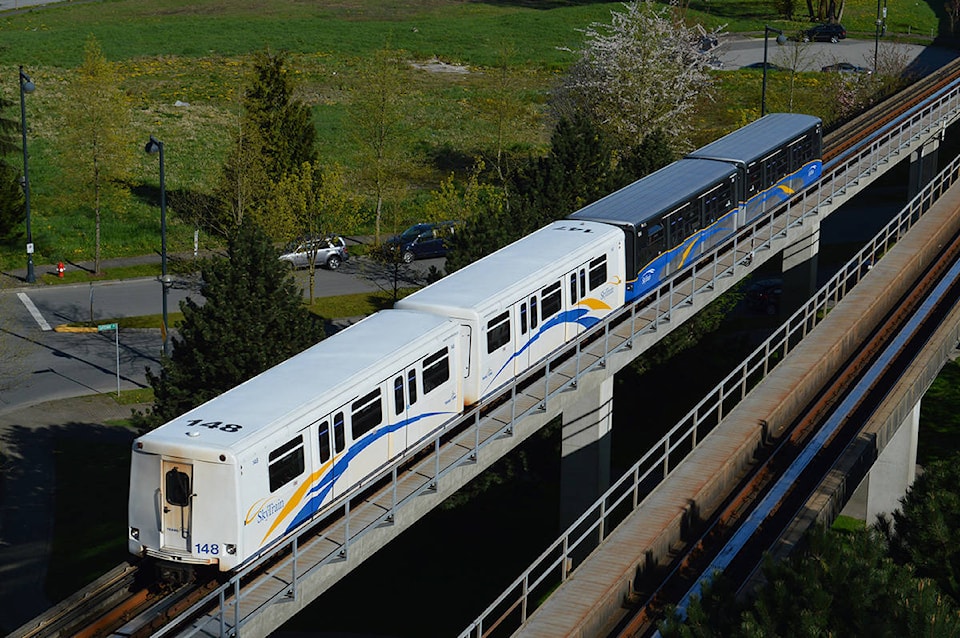The Surrey-Langley SkyTrain extension is moving on to the next step.
TransLink’s Mayor’s Council or Regional Transportation endorsed the business case for the Surrey-Langley SkyTrain extension Thursday (Jan. 30). It also endorsed the supportive policies agreement and referred the business case to senior government.
BACKGROUND: Surrey-Langley SkyTrain business case to go to mayor’s council next week, Jan. 24, 2020
READ ALSO: TransLink estimates the entire Surrey-Langley SkyTrain route would cost $3.12B, July 19, 2019
TransLink then expects final approval this summer, with construction beginning in roughly two years, sometime in 2022.
That timeline, however, only applies to the first phase of the project, which will only be built out to 166th Street in Fleetwood.
The first phase would take about five-and-a-half years from the approval date, with the anticipated opening date in late 2025.
Currently, there is about $1.63 billion in available funding which is enough to construct the extension from King George Station to 166th Street and Fraser Highway.
The full line, TransLink previously noted, would cost about $3.1 billion.
However, if TransLink is unable to secure that funding within the next year, that cost would go up.
In a news release, Surrey Mayor Doug McCallum said that while the switch in technology from light rail to SkyTrain is “no easy feat,” this is “undoubtedly the right thing to do not only for Surrey, but for the region as a whole.”
He thanked his colleagues on the mayor’s council for their support and “recognition that rapid transit expansion South of the Fraser is long overdue.”
However, during the meeting, Village of Belcarra Mayor Neil Belenkie said that it was “concerning” that they were being asked to approve a business case that has a second phase “with no guarantee we’ll be able to secure the funding.”
“If we’re going to consider projects we can’t afford, we might as well take a look at the metrics to see what it would take to support another project we couldn’t afford with the same amount of money,” Belenkie said. “I think the project from Surrey to Langley is essential — it’s got to happen, but the numbers you’re giving are skewing because it’s a completed project you’re showing the benefits for and there’s no money to complete it.
“I think we have to keep that in mind and if we’re looking at projects we can’t afford, let’s take a look at the potential impact of a bridge to the north shore.”
Jeff Busby, Surrey-Langley SkyTrain project director, said that the benefits from King George Station to Fleetwood “has merits even in that initial segment.”
“The ridership is strong. In fact, it exceeds what we see on the Evergreen extension today.”
Belenkie said that as a standalone project, the $1.6 billion “could fund five more projects” for the region.
“No one, I think, in their right mind would think — well, except for the guy who lives at 166th so he’s got easy transport from his house — would think that is the primary use of funds for this.”
Then, there was concern for the number of stations.
The length of the full project would be 16 kilometres with eight stations. However, with the first phase only going to 166th Street, there are currently plans for eight stations: 140th Street, 152nd Street, 160th Street and 166th Street.
District of North Vancouver Mayor Mike Little said some of the stations appeared to be “quite close together.”
The closest stations would be 160th and 166th streets which are about 1.5 kilometres apart.
“Some of them leave only about eight blocks of distance between one side and the next station which means that someone would only have to walk about five blocks to go to two stations, which is as a Northshore community that doesn’t have rapid transit, it’s kind of a level of service that I find a little bit surprising,” Little said.
However, Busby said with eight stations over 16 kilometres that puts the average spacing between stations “a little bit longer than our system average which is about 1.5 kilometres.”
He added that some of the stations are “relatively close together,” but that TransLink is projecting “more than half” of the eventual users “will be arriving from beyond walking distance.”
Meantime, Richmond Mayor Malcolm Brodie asked if the population in each of the areas surrounding “justify those stations that are planned.” Brodie pointed to the Capstan Station on the Canada Line which only now being funded, Olympic Village Station that was funded by Vancouver and the Gateway Station that was funded by development.
Busby said that each of the four stations between King George and 166th Street are on major north-south and east-west routes with “existing frequent bus service on it.”
Using 152nd Street as an example, Busby said it’s a bus corridor that “travels 10 or more kilometres” south all the way to the U.S. border.
“We are predicting that people will travel from South Surrey, up to connect into the SkyTrain there and that’s generating quite a bit of the ridership at that station,” he said.
READ ALSO: Surrey council unanimously passes motion to ‘cancel’ LRT, Nov. 5, 2018
READ ALSO: Metro Vancouver mayors cancel Surrey LRT in favour of SkyTrain, Nov. 15, 2018
lauren.collins@surreynowleader.com
Like us on Facebook Follow us on Instagram and follow Lauren on Twitter
